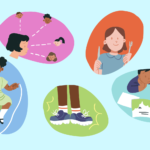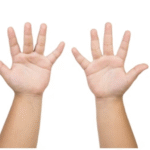Self-care skills or activities of daily living (ADLs) are the everyday activities individuals engage in to take care of their fundamental needs. The self-care skills include feeding, eating, dressing, toileting, and bathing. Occupational therapists work with individuals across the lifespan to increase independence in occupations including ADLs. As children develop, they become more independent in their everyday self-care tasks. Children with developmental delays may progress more slowly through the self-care milestones. The developmental domains are interrelated. For example, the development of fine and gross motor skills contributes to the development of self-care skills. Engaging in self-care skills can also promote development of fine and gross motor skills. Occupational therapists work with children to develop all the skills necessary to improve independence in self-care tasks.

0-6 months:
-
Eating Skills:
- The rooting and sucking reflexes are present at birth for most newborns; the rooting reflex helps the baby find the mother’s breast and the sucking reflex allows the baby to nurse or drink from a bottle
- The suck-swallow breathe pattern becomes more coordinated by 2-4 months
- Oral-motor strength increases by 4 months which leads to development of stronger suction while nursing or drinking from a bottle
-
Feeding Skills:
- Infants are nursed or bottle-fed by caregivers
6-12 months:
-
Eating Skills:
- Oral-motor strength increases which leads to development of strong up and down tongue movements while sucking
- Begins to munch on solid food with up and down jaw movements by 6 months
- Development of diagonal jaw movements while chewing begin to emerge at 7 months
- Side-to-side tongue movements develop
- Rotary chewing pattern (circular motion of jawbone during chewing) begins to emerge at 12 months
-
Feeding Skills:
- Development of self-feeding begins to emerge due to development of upright sitting posture and strengthening of neck and core muscles
- Begins to hold bottle at 6-7 months
- Begins to finger feed by 7-8 months
- Begins to hold spoon at 9 months
- Emerging use of spoon to self-feed (messy) at 11-12 months
- May begin to drink from sippy cup at 8 months and drink from a cup at 12 months

1-2 years:
-
Eating Skills:
- Rotary chewing pattern fully established (18-23 months)
- Can eat soft meat and many foods that are cut into small pieces
- Development of lip closure or lip seal around cup
-
Feeding Skills:
- Continued development of self-feeding using a spoon (with some spilling)
- Proficient in drinking from cup with lid
- Emerging ability to drink from open-top cup at 2 years
-
Toileting:
- Communicates (either verbally or with gesture) when diaper is wet
- Emerging control of bladder and bowel movements
- Tolerates diaper change
-
Dressing:
- Removes hat (15-16 months)
- Removes socks (15-18 months)
- Begins to help with dressing by finding arm hole and pushing arm through sleeve, and extending leg
- Removes shoes (with untied laces) (18 months)
- Begins to unzip zipper and zip large zipper (18-21 months)
- Begins to assist with putting on shoes (21 months)
- Helps pull down pants at 2 years
-
Bathing and Grooming:
- Begins learning to wash and dry hands (19-24 months)

2-3 years:
-
Eating Skills:
- Able to eat regular food; small (pre-cut) pieces of tough meat can be eaten
-
Feeding Skills:
- Improved proficiency with using a spoon; holds spoon in fingers (palm-up) (24-30 months)
- Uses a fork (30-36 months)
- Begins to unwrap food at 2 years
-
Toileting:
- Uses toilet with help (24-36 months)
- Better control of bladder and bowel movements during the day
-
Dressing:
- Unbuttons large buttons (24-25 months)
- Undresses with help; can remove some clothing independently including coat, pajamas, and pants with elastic waistband (26-32 months)
- Dresses with assistance; can put on button-up shirt (without buttoning buttons) and coat (28-30 months)
- Buttons large buttons (30-36 months)
- Dresses with supervision (32-36 months); needs help fastening clothing
-
Bathing and Grooming:
- Washes hands with supervision (24-30 months)
- Brushes teeth with help (24-36 months)
- Dries hands (30-36 months)
- Helps with washing self in bath (30-36 months)
3-4 years:
-
Eating Skills:
- Able to eat regular food; small (pre-cut) pieces of tough meat can be eaten
-
Feeding Skills:
- Uses spoon and fork without spilling food
- Drinks from water fountain (with help turning fountain on)
- Begins to prepare simple foods
- Begins to open food containers
-
Toileting:
- Uses toilet with assistance with wiping
-
Dressing:
- Emerging independence in dressing and undressing
-
Bathing and Grooming:
- Washes and dries hands independently
- Washes self in bath with help
- Dries self after bath with help

4-5 years:
-
Eating Skills:
- Able to eat regular food; small (pre-cut) pieces of tough meat can be eaten
- Chews with lips closed
-
Feeding Skills:
- Can eat soup with a spoon
- Spreads with a knife
- Drinks from water fountain independently
-
Toileting:
- Wipes self while using toilet
-
Dressing:
- Undresses independently; unzips and unbuttons large buttons independently
- Dresses with some assistance with fasteners and orientation
- Zips up jacket when zip is started
- Buttons-up clothing with large buttons
- Puts on socks and shoes with assistance tying shoes
-
Bathing and Grooming:
- Brushes teeth and performs grooming tasks with supervision
- Bathes with some assistance with water

5-6 years:
-
Eating Skills:
- Fully independent
-
Feeding Skills:
- Continues to learn how to open food packaging
- Begins to cut meat independently
-
Toileting:
- Fully independent
-
Dressing:
- Needs assistance choosing clothes
- May need help with certain fasteners like belts
-
Bathing and Grooming:
- Brushes teeth and performs grooming tasks with supervision
- Bathes self with some assistance setting up bath and washing hair; also requires supervision for safety while bathing
7-10 years:
-
Dressing:
- May need help choosing suitable clothing for weather or specific activity
-
Bathing and Grooming:
- Independent with bathing and grooming but may require reminder to bathe/groom and cue to perform task thoroughly






